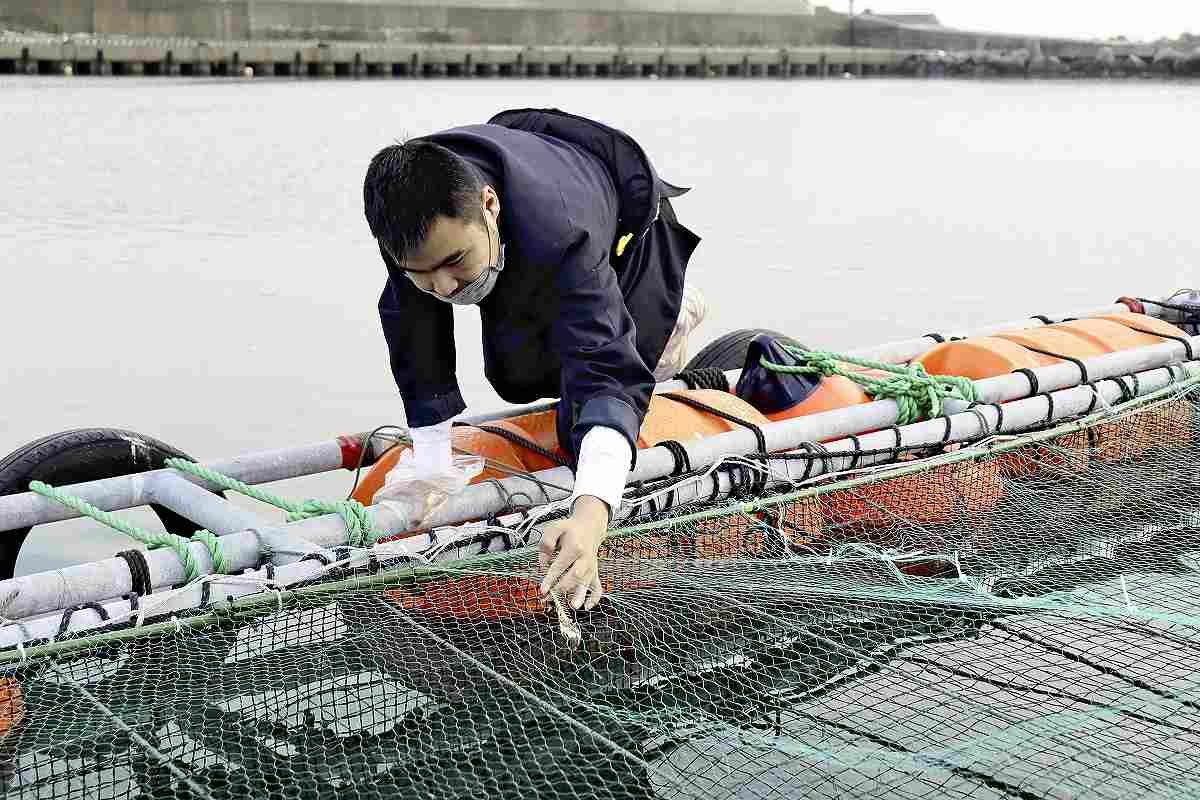
A student of Ibaraki Prefectural Kaiyo High School checks on a fish farming pen of common mackerel in Hitachinaka, Ibaraki Prefecture.
15:00 JST, February 14, 2023
MITO — Ibaraki Prefecture boasts of being Japan’s largest source of caught mackerel, and the prefectural government wants to make its fish farming a sustainable industry that future generations can inherit. Currently, it is conducting an experiment where information communications technology, which includes artificial intelligence, is used for common mackerel farming. Students of a local high school are cooperating with the prefectural government on the management of fish farming pens.
The project aims to build a system in which underwater cameras and other devices will monitor water temperature and the condition of fish while an AI system controls feeding. They aim to ship out the farmed fish to markets in autumn of this year at the earliest.
Cutting costs
Ibaraki Prefecture seashores face the Pacific Ocean to form a curve and are easily affected by waves, making it unsuitable for fish farming. According to the Fisheries Agency, it is rare that a prefectural government with few achievements in the past in fish farming, such as the one in Ibaraki Prefecture, tries fish farming by utilizing AI and similar technologies.
One evening in mid-January, three members of a fisheries club in Ibaraki Prefectural Kaiyo High School prepared to feed fish at the Nakaminato fishing port in Hitachinaka, Ibaraki Prefecture.
The students stood beside a fish farming pen located on the sea surface measuring five meters in length and width and 2.5 meters deep. They took food consisting of powdered fish meat and other ingredients from a bag weighing 20 kilograms and inserted it into a feeding machine.
The prefectural government began raising 10,000 baby mackerels that were about 15 centimeters long and weighed about 50 grams in autumn of last year.
Ryoma Orikasa, 17, a third-year student of the high school, said, “This is a precious experience for me as I can get involved in an activity that is advanced. I feel rewarded when I see the fish growing larger little by little.”
The prefectural government aims to demonstrate the feasibility of an AI-operated feeding system. After cameras and sensors record water temperature, salt density and images of the common mackerel, operators will have the AI learn the proper amount for and intervals between feedings.
By reducing leftover feed as much as possible, the prefectural government aims to cut costs and contribute to preservation of sea environments.
The high school proposed helping out as it regards the project as a good opportunity for its students to learn about fish farming.
Six members of the high school’s fisheries club work on the project four times a week. They check to make sure the amount of feed is correct, mainly in places where the underwater cameras have blind spots, remove dead fish, and provide data about the common mackerel to the prefectural government for the AI to learn from.
“I want to accumulate experiences and utilize them in the future,” said third-year student Reon Uchikoshi, who will join a fish farming company this coming spring.
Served raw
According to the central government’s statistics in 2021, the prefecture’s volume of caught mackerel was 73,800 tons, the largest in the nation.
In recent years, volumes of saury and salmon have been poor nationwide. This has spurred the prefectural government to establish expertise on fish farming which will enable stable supplies in the future through its experiment.
Many wild mackerel caught in the prefecture have been shipped as frozen or canned foods to avoid the risk of parasites, and the prefectural government aims to serve raw fish products by selling the farmed mackerel that are fed with man-made products.
The common mackerel in the fish pen have grown to be about 20 centimeters long and weighed about 90 grams in late last year. They are expected to grow to a size suitable for shipping — 30 centimeters long and about 400 grams in weight — within a year.
The prefectural government will ship the fish on a test basis in autumn of this year through a warehouse company in Yokohama that has a nationwide sales network to determine the experiment’s profitability.
“We want to expand fish farming as another pillar in addition to marine fisheries,” said a prefectural government official.
"Features" POPULAR ARTICLE
-

Sanrio to Open Museum in Yamanashi Pref. Dedicated to Founder, Exhibits Include Hello Kitty, Other Characters
-

Autumn Foliage Surrounds Visitors to Tokyo’s Showa Kinen Park
-

My Daughter No Longer Speaks to Me, But I Want to See Her and My Grandchild
-

Kumamoto: Public Bath Refurbished as Library Where You Can Chat, Take Photos
-

Frozen Vegetables: Demand Rises for Convenient, Tasty Domestic Produce
JN ACCESS RANKING
-

Keidanren Chairman Yoshinobu Tsutsui Visits Kashiwazaki-Kariwa Nuclear Power Plant; Inspects New Emergency Safety System
-

Tokyo Economic Security Forum to Hold Inaugural Meeting Amid Tense Global Environment
-

Imports of Rare Earths from China Facing Delays, May Be Caused by Deterioration of Japan-China Relations
-

University of Tokyo Professor Discusses Japanese Economic Security in Interview Ahead of Forum
-

Japan Pulls out of Vietnam Nuclear Project, Complicating Hanoi’s Power Plans
























